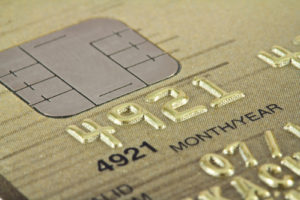Special to the Financial Independence Hub
For years, we got used to swipe, type and go. Then, all of a sudden, we were forced to insert our cards and wait, like we’ve been thrown back to the Stone Age. Well, you will be pleased to know that it was not a step backward. This is real progress for the protection of the cardholder.
What makes the chip so different?
The difference between the chip and the magnetic strip is bigger than just your experience when you check out. When you swipe your card at the terminal, your personal information is vulnerable. We have seen this numerous times in major department stores over the years. All it takes is one good hacker, and all of the information on every card ever swiped within that database is up for grabs.
Yes, that means identity theft.
With the new chip, all of that information is encrypted before it is processed. What does that mean? In a nut shell, your information is transmitted as a one-time-use code. No more hanging your personal info out there for someone to grab a hold of. This doesn’t mean the codes are unbreakable, just that it takes a whole lot more to crack them.
In addition to that, the chip can’t be counterfeited. That magnetic strip on the back of your card, which you’ve been swiping forever, can easily be duplicated. If someone gets their hands on your card, that one strip could quickly turn into hundreds. If you have a chip card stolen, the culprit must have your personal identification number (PIN) in order to use it. And because it can’t be copied, there will only be one bad guy to track down.
When did the chip come into play?
The United States just adopted the more secure way to pay in 2015. But, believe it or not, the chip card has been around since 1994. Fraud was a huge problem in Europe, so they decided to change the way they make transactions by using this seemingly new technology. Since they made the change, Europeans have saved millions that would have been lost to fraud and counterfeiting. Slowly but surely, the rest of the world is following suit.
Why do I have to use them?
Over the years, we have all learned better ways to protect ourselves from identity theft and fraud. We change our PIN numbers regularly, shred our documents, don’t give out our social security numbers over the phone and so on. The problem is, however, that businesses may not be as careful with our information.
Therefore, we see systems full of customer information being hacked. Millions of people are at risk of losing it all, and just because they had to buy some new socks for their son. Without data encryption, our livelihoods are available to an expert hacker.
But why do I HAVE to?
The answer is simple … Soon there will be no choice. Some companies are taking their time with the transition because it costs money to update and reprogram systems. In the beginning, major banks shipped out replacements, but the smaller ones may need some more time to get them out. Eventually, however, all the banks and businesses will accept and offer the new chip card technology. So, why do you have to? Because that’s all there will be.
Does this mean Identity Theft will be a thing of the past?
Unfortunately, probably not. The chip card technology is definitely superior to the magnetic strip, but, in time, hackers may be able to break some codes. It’s what they do. In today’s world of modern, electronic and virtual ways, it is necessary to update and upgrade to prevent these types of crimes.
The banks that issue the cards will constantly change the details of your chip to protect you, while still allowing you to maintain the same process at checkout. But, in the future, don’t be surprised to see a whole new way to pay come into play. It’s the state of world now, and embracing advancements will keep the ball rolling smoothly.
 Jessica Kane is a professional blogger who writes for Faxage, a leading company that provides Internet fax service for individuals and businesses.
Jessica Kane is a professional blogger who writes for Faxage, a leading company that provides Internet fax service for individuals and businesses.


